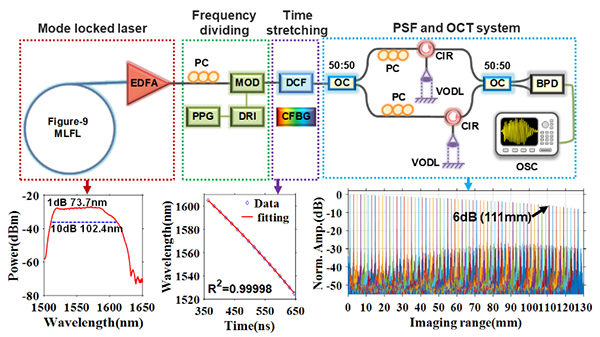High-performance swept sources with high sweep rate, flat spectrum, wide sweep range and long coherence length will find applications in many photonic systems, especially in optical coherence tomography (OCT) and LiDAR. OCT technology was rapidly commercialized after its invention by D. Huang et al. in 1991. Swept source OCT is a promising candidate to satisfy the increasing demand for real-time high-speed imaging in the next generation OCT. In a swept source OCT system, a single-point high-speed photodetector is utilized to acquire the interference signal of the reflected light from the reference arm and the sample arm of the Michelson interferometer. The axial scan rate can be up to tens of millions of scans per second benefiting from the high-speed photodetector and the motionless configuration. When the bandwidth of the photodetector is sufficiently large, the performance of the swept source OCT depends predominantly on the performance of the swept source. MEMS-VCSEL, Fourier domain mode locked laser, and time-stretched swept laser have been proposed to be the swept sources of megahertz OCT. Among them, the swept source based on time-stretching is the only technology that has demonstrated sweep rates higher than 10 MHz. A highly coherent seed laser with a high repetition rate and a broad flat spectrum is the key to generate high performance time-stretched swept source. The spectrum of mode locked fiber laser output however is not sufficiently broad for time stretching. Supercontinuum can achieve a broad spectrum but suffers from the large shot-to-shot spectral fluctuation, which impedes its application in time-stretching. Finally, reconfiguration of time-stretched swept sources to operate at different sweep rates has not been demonstrated.
Drs. Dongmei HUANG and Feng LI from The Hong Kong Polytechnic University proposed and demonstrated a reconfigurable swept source by time-stretching technique (D. Huang, F. Li, et al., "Reconfigurable time-stretched swept laser source with up to 100 MHz sweep rate, 100 nm bandwidth, and 100 mm OCT imaging range", Photonics Research, Volume 8, Issue 8, 2020). The swept source has an effective sweep range of 100 nm with a sweep rate adjustable from 2.5 to 100 MHz and a corresponding adjustable sweep slope. The swept source is applied to an OCT system and more than 100 mm imaging range is demonstrated. The reconfigurable time-stretched swept source is composed of a mode locked fiber laser, frequency dividing module, and time-stretching component. A compact figure-9 configuration mode locked fiber laser serves as the seed source. The mode locked laser outputs highly stable femtosecond pulses at a repetition rate of 100 MHz and a spectral bandwidth ~40 nm. The seed pulses are then injected into a dispersion-managed Er-doped fiber amplifier to obtain a flat broad spectrum with a 10-dB bandwidth >100 nm and a 1-dB bandwidth >73 nm based on nonlinear broadening. The frequency dividing module consists of an optical intensity modulator and a pulse pattern generator which generates frequency-divided pulse sequences for the optical modulator to vary the repetition rate. Different combinations of multiple dispersion compensation modules (chirped fiber Bragg grating and/or dispersion compensation fiber) are used to realize swept sources at selected swept rates from 2.5 to 100 MHz based on the time-stretching technique. At 2.5 MHz swept rate, the 6 dB sensitivity roll-off length of the OCT system is 111 mm. This is the first demonstration of megahertz OCT with an imaging range longer than 100 mm.
Professor P.K.A. WAI believes that this high-performance reconfigurable time stretched swept source will expand the application of OCT systems. The 100 MHz ultra-fast OCT system can greatly increase the frame rate of 4D imaging and also can be used for tomography of high-speed moving objects. The long imaging range of the OCT system is useful in endoscopic imaging of large-scale objects and alleviates problems such as short detection distance and difficulty in positioning the endoscopic probe. Besides biomedical imaging, the increase in imaging range will extend the application of such technique to other areas such as 3D model construction and high-speed LiDAR.

Schematic diagram of scanning laser experimental device


